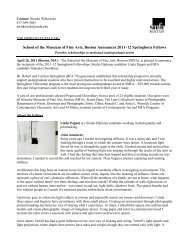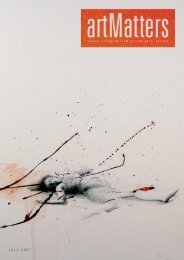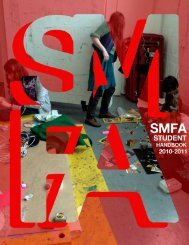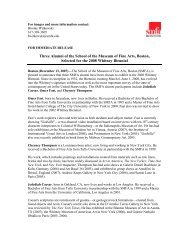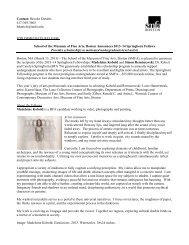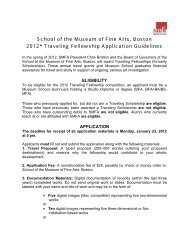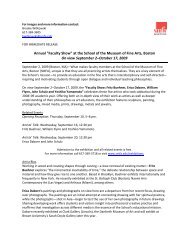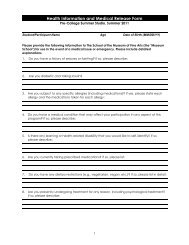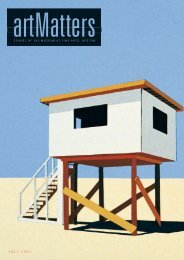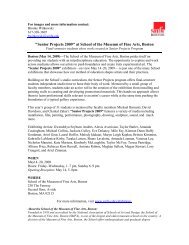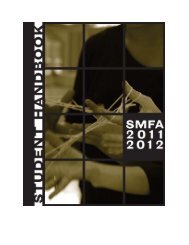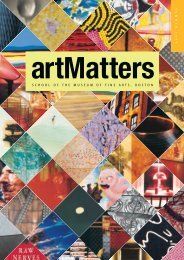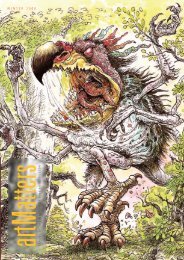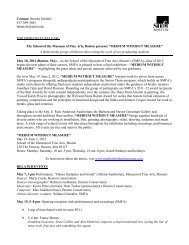Fall 2013 Course Catalog - School of the Museum of Fine Arts
Fall 2013 Course Catalog - School of the Museum of Fine Arts
Fall 2013 Course Catalog - School of the Museum of Fine Arts
Create successful ePaper yourself
Turn your PDF publications into a flip-book with our unique Google optimized e-Paper software.
<strong>Fall</strong> <strong>2013</strong> <strong>Course</strong> <strong>Catalog</strong><br />
32<br />
Flatlands: Beginning<br />
Abstraction<br />
PAI 1034 01 (2 Credits)<br />
Angelina Gualdoni<br />
T<br />
2:00 PM - 5:00 PM<br />
B309<br />
How does one begin an abstract painting? How does one choose colors, arrangement,<br />
or scale? In Flatlands, we will complete a series <strong>of</strong> projects exploring design principles as<br />
applied to non-objective artworks. Using acrylic paint, ink and collage, students will engage<br />
with tactics and strategies for utilizing non-objective imagery towards self-directed content.<br />
Each week will bring a new design problem, with lessons culminating in a small body <strong>of</strong><br />
work on paper or canvas, exploring a <strong>the</strong>me <strong>of</strong> <strong>the</strong> students choice. Projects will emphasize<br />
brainstorming multiple answers to visual problems over selecting <strong>the</strong> first solution that comes<br />
to mind. We will examine examples <strong>of</strong> abstraction that span continents and centuries,<br />
including 20th century pop, minimal, ab-ex, and post-modern painting, but also non-western<br />
textiles and ceramics. Midterm and Final critiques will be devoted to evaluating a student’s<br />
ability to manipulate composition, shape, space, edge, color and form towards issues <strong>of</strong> <strong>the</strong>ir<br />
choosing. At <strong>the</strong> conclusion <strong>of</strong> <strong>the</strong> class, student should show ability to “speak graphically”,<br />
utilizing above topics to inform <strong>the</strong>ir decisions as <strong>the</strong>y move fur<strong>the</strong>r into painting, printmaking,<br />
or drawing. Please not we will not cover oil paint in this class. This course will focus on<br />
acquisition <strong>of</strong> basic 2d skills (color, line, shape, tone, etc.) that serve as a basis for making/<br />
designing images across multiple media. While this class is housed in <strong>the</strong> painting area,<br />
techniques and principles are applicable to advanced drawing, printmaking, and collage<br />
strategies. Media used will include charcoal, diverse collage material, pigment, and acrylic<br />
paint. While <strong>the</strong> principles introduced carry into multiple media, most <strong>of</strong> <strong>the</strong> examples that<br />
we will examine will be abstract – in <strong>the</strong> broadest sense <strong>of</strong> <strong>the</strong> word, including Western and<br />
Non-Western paintings, textiles, ceramics, drawings, etc. As such, this class serves as an<br />
excellent entry point into considering meaning and form in contemporary abstraction.<br />
Intermediate Projects<br />
PAI 2000 01 (2 Credits)<br />
Angelina Gualdoni<br />
T<br />
6:00 PM - 9:00 PM<br />
B309<br />
Moving from beginning courses (where work is made in response to assignments) to<br />
developing a body <strong>of</strong> work with personal vision and expression is an important step in<br />
developing as a student and artist. This one-period course prepares students to move into<br />
<strong>the</strong> intermediate and advanced levels <strong>of</strong> instruction where personal commitment, vision, and<br />
curiosity are driving <strong>the</strong> work. Slide lectures, readings, discussions, group and individual<br />
critiques help students identify subjects <strong>the</strong>y care passionately about and want to explore<br />
through paint and related media. Class time is divided between <strong>the</strong>se activities with emphasis<br />
on developing a strong working community through critique. Students should be prepared<br />
to spend a good deal <strong>of</strong> time working individually outside <strong>of</strong> class. It is strongly suggested<br />
that all students take this course at some point in <strong>the</strong>ir second year <strong>of</strong> study.Though this<br />
course is <strong>of</strong>fered in <strong>the</strong> Painting Area, it is open to students wishing to work in o<strong>the</strong>r media<br />
as well. This class is generally not recommended for freshman, but open to all students who<br />
have achieved a level <strong>of</strong> comfort within <strong>the</strong> medium <strong>of</strong> <strong>the</strong>ir concentration (an introductory<br />
course AND an additional 1000 or 2000 level course before entering Intermediate Projects<br />
is required).<br />
Abstraction, Representation,<br />
Criticality<br />
PAI 2001 01 (4 Credits)<br />
Angelina Gualdoni<br />
W<br />
9:00 AM - 12:00 PM /<br />
2:00 PM - 5:00 PM<br />
B309<br />
This course will introduce students to <strong>the</strong> practical and historical dialog between<br />
representational and abstract modes <strong>of</strong> painting. A series <strong>of</strong> class projects lead students<br />
through a conversation between <strong>the</strong>se two modes <strong>of</strong> painting, with <strong>the</strong> goal <strong>of</strong> examining<br />
<strong>the</strong>ir underlying assumptions, and complicating <strong>the</strong> categories <strong>of</strong> “representation” and<br />
“abstraction”. It has <strong>of</strong>ten been said “all painting is abstract and in that <strong>the</strong> artist chooses<br />
to emphasize some things over o<strong>the</strong>rs”. Class projects distinguish between categories <strong>of</strong><br />
“non-objective”, abstraction in <strong>the</strong> sense <strong>of</strong> emphasis or distortion, as well as <strong>the</strong> quality <strong>of</strong><br />
abstraction inherent in conventional representation. Class concludes with several weeks<br />
<strong>of</strong> independent student work. Emphasis will be production <strong>of</strong> paintings, and talking about<br />
painting with informed intent. Students will leave this class able to understand and apply<br />
<strong>the</strong> basic techniques <strong>of</strong> representational painting (modeling to create form, atmospheric and<br />
linear perspective to create space, proportion and good composition), able to understand and<br />
apply basic techniques <strong>of</strong> abstraction (composition, materials, color, brushstroke, layering,<br />
transparency, abstraction from nature). Students should also be able to understand and<br />
discuss <strong>the</strong> historical roles abstraction and representation have played in painting history<br />
and how <strong>the</strong>y apply to <strong>the</strong>ir own work. Attendance is required for this course. Some prior<br />
painting experience is required before taking this course. An introductory Painting course<br />
or permission <strong>of</strong> <strong>the</strong> instructor is a pre-requisite for Abstraction, Representation, Criticality.



